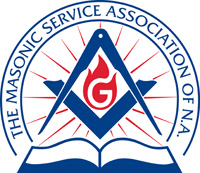written by Richard E. Fletcher, 33°, Executive Secretary MSANA
What do we really mean by the term Masonic Education? After all, learning can be accomplished by something as informal as two brothers talking about the fraternity over a cup of coffee, to the more formal membership in a Masonic Lodge of Research. So how do we define what this term? Simply stated, Masonic Education is any source through which a Mason becomes more knowledgeable about his fraternity.
Small discussion groups have been very popular in lodges around the country. Informal groups discuss such things as Masonic ritual, the esoteric aspects of the fraternity, charitable activities of the lodge, and the lodge’s commitment to the well-being of their community. More intense studies are done through formal groups, such as Masonic Lodges of Research, The Scottish Rite Research Society, or the Quatuor Coronati Correspondence Circle of London, England. These groups have memberships ranging from statewide to national to international.
The road to Masonic knowledge is not easy, simple, or a sure thing and requires commitment, effort, and a desire to learn. But then that’s the true nature of the fraternity itself. The journey toward Masonic Enlightenment through knowledge begins with the new Mason asking simple questions such as—“Why is my lodge called a blue lodge?” “Why is the Master of the Lodge called Worshipful?” These are very basic questions, but the answers do constitute Masonic Education. And it behooves us, as the Masons of today, to be ready to answer them correctly.
We are now experiencing a generational change in our fraternity. Not too many years ago it was very common for all lodges to have a multi-generational membership. That generational balance changed during the 1960s and 1970s. Freemasonry, like all value-based organizations, suffered membership losses during this period.
Now we are beginning to see a new generation no longer accepting that attitude and searching for a pathway that will help them find fellowship and a way to work toward self-improvement. We must recognize this change and be prepared to work with our newer, younger members in such a way that they feel welcome in the fraternity. Newer members are inquisitive, curious, and intellectually prepared to learn. So how do they go about the process of learning? No greater assistance can be given to our newer members than the ability to answer their questions or to guide them in a direction where they can find the answer. It would be ideal if every lodge had a small library and a link to a larger Masonic library.
Another direction the individual Mason should pursue is self-help. For example, the Masonic Service Association of North America was formed in 1919, in part, to provide Masonic Educational material to Freemasons. In 1923 we began publishing the Short Talk Bulletin, a monthly publication of Masonic interest. We have printed one every month since, and they include a myriad of Masonic information. MSA also publishes digests and has both a monthly and a quarterly newsletter. The Masonic Information Center—part of the MSA—is charged with the responsibility of providing factual, accurate information about the fraternity, not only to our own members but to the media and the general public as well. You can go to our website at www.msana.com to see the wealth of information that we have available.
Learning about the rich and colorful history of Freemasonry takes one on a marvelous journey. True Masonic Education is nothing more than a combination of the attentive ear, the instructive tongue, and the willingness and desire to gain Masonic knowledge. Exploration of the Masonic world is open to all with the desire to learn.







